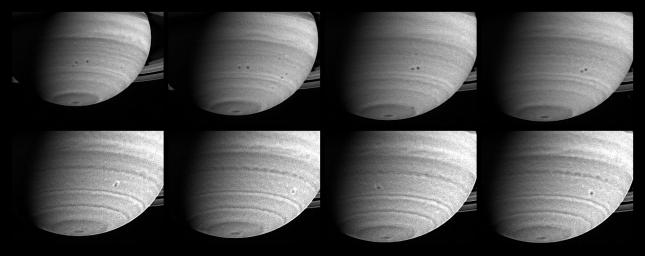
|
Merging Saturnian Storms
- Click the image above for a larger view
- Full-Res JPEG (1360 x 540) (103.5 kB)
- Full-Res TIFF (1360 x 540) (604.7 kB)
Caption:
Three months before its scheduled arrival at Saturn, the Cassini spacecraft has observed two storms in the act of merging. With diameters close to 1,000 kilometers (621 miles), both storms, which appear as spots in the southern hemisphere, were seen moving west, relative to the rotation of Saturn's interior, for about a month before they merged on March 19 through 20, 2004.
This set of eight images was taken between Feb. 22 and March 22, 2004. The top four frames span 26 days. They are portions of images from the narrow angle camera taken through a filter accepting light in the near-infrared region of the spectrum centered at 619 nanometers, and they show two storms approaching each other. Both storms are located at 36 degrees south latitude and sit in an anti-cyclonic shear zone, which means that the flow to the north is westward relative to the flow to the south. Consequently, the northern storm moves westward at a slightly greater rate than the southern one, 11 meters versus 6 meters per second (25 and 13 mph), respectively. The storms drift with these currents and engage in a counterclockwise dance before merging with each other.
The bottom four frames are from images taken on March 19, 20, 21 and 22, in a region of the spectrum visible to the human eye; they illustrate the storms' evolution. Just after the merger, on March 20, the new feature is elongated in the north-south direction, with bright clouds on either end. Two days later, on March 22, the storm has settled into a more circular shape, and the bright clouds have spread around the circumference to form a halo. Whether the bright clouds are particles of a different composition or simply at a different altitude is uncertain.
The new storm is a few tenths of a degree farther south than either of its progenitors. There, its westward velocity is weaker, and it is almost stationary relative to the planet's rotation. Although these particular storms move slowly west, storms at Saturn's equator move east at speeds up to 450 meters per second (1,000 mph), which is 10 times the speed of Earth's jet streams and three times greater than the equatorial winds on Jupiter. Saturn is the windiest planet in the solar system, which is another mystery of the ringed giant. The image scale ranges from 381 kilometers (237 miles) to 300 kilometers (186 miles) per pixel. All images have been processed to enhance visibility.
Background Info:
The Cassini-Huygens mission is a cooperative project of NASA, the European Space Agency and the Italian Space Agency. The Jet Propulsion Laboratory, a division of the California Institute of Technology in Pasadena, manages the Cassini-Huygens mission for NASA's Office of Space Science, Washington, D.C. The Cassini orbiter and its two onboard cameras, were designed, developed and assembled at JPL. The imaging team is based at the Space Science Institute, Boulder, Colo.
For more information, about the Cassini-Huygens mission visit, http://saturn.jpl.nasa.gov and the Cassini imaging team home page, http://ciclops.org .
Cataloging Keywords:
| Name | Value | Additional Values |
|---|---|---|
| Target | Saturn | |
| System | Saturn | |
| Target Type | Planet | |
| Mission | Cassini-Huygens | |
| Instrument Host | Cassini Orbiter | |
| Host Type | Orbiter | |
| Instrument | Imaging Science Subsystem (ISS) | |
| Detector | Narrow Angle Camera | |
| Extra Keywords | Atmosphere, Grayscale, Infrared, Rotation, Storm, Visual | |
| Acquisition Date | ||
| Release Date | 2004-04-08 | |
| Date in Caption | 2004-03-22 | |
| Image Credit | NASA/JPL/Space Science Institute | |
| Source | photojournal.jpl.nasa.gov/catalog/PIA05386 | |
| Identifier | PIA05386 | |
